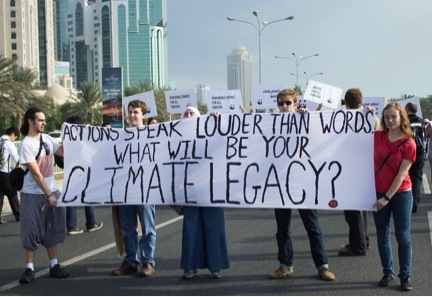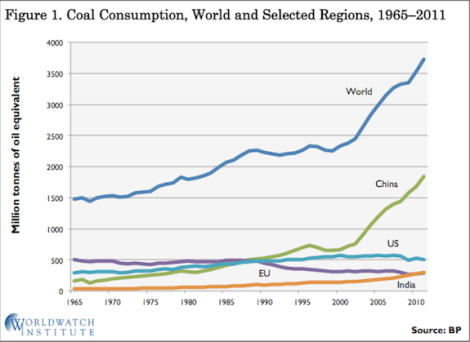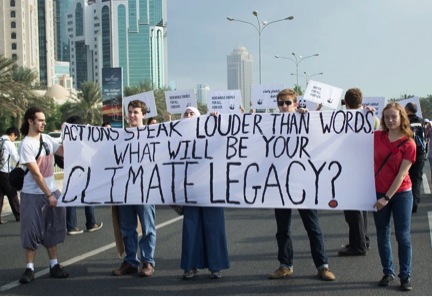In 1997, most of the world’s nations signed on to the Kyoto Protocol, a treaty intended to fight climate change. The goal was to gradually cut greenhouse gas emissions through the end of 2012, the first commitment period. How’d we do? From the CBC:
The controversial and ineffective Kyoto Protocol’s first stage comes to an end today, leaving the world with 58 per cent more greenhouse gases than in 1990, as opposed to the five per cent reduction its signatories sought.
Ah, well. Worth a shot!
If there is anything good that came out of the Kyoto experience, it is that the issue it tried and failed to tackle is now top of mind, says [Steven Guilbeault of Equiterre, a Montreal-based environmental group].
“That’s probably one of the biggest accomplishments of the Kyoto Protocol, is making climate change something that’s part of our everyday life.”
You know what else is making climate change something that’s part of our everyday life? Climate change.

One reason Kyoto has been such a failure is its unenforceability. As our David Roberts put it on Twitter:
Kyoto’s lesson is a familiar one: nations will not act against what they perceive as their own self-interest based on an int’l treaty.
— David Roberts (@drgrist) January 2, 2013
For example, in the United States. President George W. Bush refused to support the protocol out of fear it would hurt the American economy. Our carbon emissions plummeted anyway — thanks largely to the economic slowdown.
Another reason Kyoto failed is that it exempted China, India, and other “developing” countries from emissions cuts during its first phase. By the end of 2011, coal use globally reached a new high, spurred by China and India.

From the Worldwatch Institute:
Coal use increased by 5.4 percent to 3,724.3 million tons of oil equivalent (mtoe) from the end of 2010 to the end of 2011. Demand for natural gas grew by 2.2 percent in 2011, reaching 2,905.6 mtoe. …
Spurred mainly by demand growth in China and India, coal’s share in the global primary energy mix reached 28 percent in 2011 — its highest point since the International Energy Agency began keeping statistics in 1971. While the United States remained one of the world’s largest coal users, consumption growth in 2011 was concentrated among countries that are not part of the Organisation for Economic Co-operation and Development (OECD), including China and India. Consumption in non-OECD countries grew by 8.4 percent to 2,625.7 mtoe. These countries accounted for 70.5 percent of global coal consumption in 2011.
We can expect to see that pattern continue as other nations increase energy use. Africa, for example, is seeing a boom in energy production and consumption. From The Christian Science Monitor:
Africa, home to 15 percent of the world’s population, consumes just 3 percent of the world’s energy output, and 587 million people, including close to three-quarters of those living in Sub-Saharan Africa, still have no access to electricity via national grids.
But the situation is changing, and swiftly. At 4.1 percent growth, Africa’s per capita energy consumption is growing faster than anywhere else, driven by improved infrastructure, inward investment, and efforts to tackle corruption.
Meanwhile, in the last five years, there have been 64 major discoveries of potential new fuel supplies — mostly oil and gas deposits. Of those, 13 were found in the first eight months of 2012 alone.
Overall, international growth in energy consumption is far outpacing interational efforts to reduce emissions.
Later this year, Poland will host the 19th annual U.N. climate summit. At worst, it can only tie last year’s summit for ineffectiveness. At best, an agreement will be reached to again try and curb global greenhouse gas emissions.
And in an ideal world choked with optimism, it might actually work.



